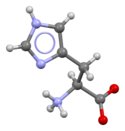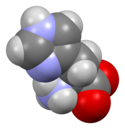
Back هستيدين Arabic هیستیدین AZB Гістыдын Byelorussian Хистидин Bulgarian Histidin BS Histidina Catalan Histidin Czech Histidin Danish Histidin German Ιστιδίνη Greek
 Skeletal formula of histidine (zwitterionic form)
| |||
| |||
| Names | |||
|---|---|---|---|
| IUPAC name
Histidine
| |||
| Other names
2-Amino-3-(1H-imidazol-4-yl)propanoic acid
| |||
| Identifiers | |||
3D model (JSmol)
|
| ||
| 84088 | |||
| ChEBI | |||
| ChEMBL | |||
| ChemSpider | |||
| DrugBank | |||
| ECHA InfoCard | 100.000.678 | ||
| EC Number |
| ||
| 83042 | |||
| KEGG | |||
PubChem CID
|
|||
| UNII | |||
CompTox Dashboard (EPA)
|
|||
| |||
| |||
| Properties | |||
| C6H9N3O2 | |||
| Molar mass | 155.157 g·mol−1 | ||
| 4.19g/100g @ 25 °C [1] | |||
| Hazards | |||
| NFPA 704 (fire diamond) | |||
| Supplementary data page | |||
| Histidine (data page) | |||
Except where otherwise noted, data are given for materials in their standard state (at 25 °C [77 °F], 100 kPa).
| |||
Histidine (symbol His or H)[2] is an essential amino acid that is used in the biosynthesis of proteins. It contains an α-amino group (which is in the protonated –NH3+ form under biological conditions), a carboxylic acid group (which is in the deprotonated –COO− form under biological conditions), and an imidazole side chain (which is partially protonated), classifying it as a positively charged amino acid at physiological pH. Initially thought essential only for infants, it has now been shown in longer-term studies to be essential for adults also.[3] It is encoded by the codons CAU and CAC.
Histidine was first isolated by Albrecht Kossel and Sven Gustaf Hedin in 1896.[4] The name stems from its discovery in tissue, from ἱστός histós "tissue".[2] It is also a precursor to histamine, a vital inflammatory agent in immune responses. The acyl radical is histidyl.
- ^ http://prowl.rockefeller.edu/aainfo/solub.htm[full citation needed]
- ^ a b "Nomenclature and Symbolism for Amino Acids and Peptides". IUPAC-IUB Joint Commission on Biochemical Nomenclature. 1983. Archived from the original on 9 October 2008. Retrieved 5 March 2018.
- ^ Kopple, J D; Swendseid, M E (1975). "Evidence that histidine is an essential amino acid in normal and chronically uremic man". Journal of Clinical Investigation. 55 (5): 881–91. doi:10.1172/JCI108016. PMC 301830. PMID 1123426.
- ^ Vickery, Hubert Bradford; Leavenworth, Charles S. (1928-08-01). "On the Separation of Histidine and Arginine" (PDF). Journal of Biological Chemistry. 78 (3): 627–635. doi:10.1016/S0021-9258(18)83967-9. ISSN 0021-9258.
© MMXXIII Rich X Search. We shall prevail. All rights reserved. Rich X Search


